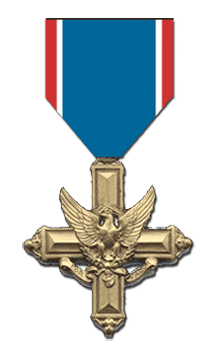
Establishing Authority
The Distinguished Service Cross was established by order of President Woodrow Wilson, as promulgated in War Department General Orders Number 6 of January 12, 1918, and formalized by Act of Congress on July 9, 1918 (Public Law 193, 65th Congress).
Effective Dates
The Distinguished Service Cross has been in effect since April 6, 1917; however, under certain circumstances the Distinguished Service Cross may be awarded for services rendered prior to April 6, 1917.
Criteria
The Distinguished Service Cross may awarded to a person who, while serving in any capacity with the Army, distinguishes himself by extraordinary heroism not justifying the award of a Medal of Honor. This extraordinary heroism must take place while the individual is engaged in an action against an enemy of the United States; or while he is engaged in military operations involving conflict with an opposing foreign force; or while he is serving with friendly foreign forces that are engaged in an armed conflict against an opposing armed force in which the United States is not a belligerent party. The act or acts of heroism must be so notable and involve risk of life so extraordinary as to set the individual apart from his comrades.
Order of Precedence
The Distinguished Service Cross is worn after the Medal of Honor and before all other decorations.
Devices
Additional awards are denoted by oak leaf clusters.
Designers
The Distinguished Service Cross was designed by First Lieutenant Andre Smith and modified by Captain Aymar Embury, both of the Camouflage Section, 40th Engineers, at Camp American University. Embury's final design was sculpted by John R. Sinnock of the Philadelphia Mint.
First Recipients
The first awards of the Distinguished Service Cross were made on March 18, 1918, to three soldiers from the 1st Division:
- Second Lieutenant John Newport Greene of the 6th Field Artillery
- Sergeant William M. Norton, Company I, 18th Infantry
- Private Patrick Walsh, Company I, 18th Infantry.
Description and Symbolism
Obverse
The second style Distinguished Service Cross is a modification of the first style; it has a sculptured inner cross mounted on a flat cross with decorative, fluted edges. At the end of each arm is a small ornamental scroll topped by a ball. An eagle with displayed wings is centered on the cross and behind the eagle is a circular wreath of laurel (which replaces the diamond in the first style cross). The laurel wreath is tied at its base by a scroll which extends into the lower re-entrant angles of the cross and contains the inscription, FOR VALOR.
Reverse
The reverse also features a sculptured inner cross on a flat cross, with the same decorations at the edges that appear on the obverse. The back and tips of the eagles wings are also shown. Centered upon the cross is a circular wreath of laurel with a bowknot at the bottom from which flows the back of the scroll, joining the arms of the cross. In the center of the wreath is a rectangular plaque with decorative edges, which is blank for engraving the recipient's name.
Ribbon
The ribbon was designed by Captain Andre Smith and has a central field of blue (one inch wide) edged in white and red, with the red forming the outermost colors of the ribbon. The colors of the ribbon are those of the flag and stand for purity (white), sacrifice (red), and high purpose (blue).
Notable Recipients
- Eddie Rickenbacker, the top U.S. aviator ace of World War I, was awarded a record eight Distinguished Service Crosses, one of which was later upgraded to the Medal of Honor, while flying with the 94th Aero Squadron.
- Three U.S. Marine legends – Daniel Daly, who was twice decorated with the Medal of Honor, and Medal of Honor recipients John H. Quick and Henry L. Hulbert – all received the Distinguished Service Cross for heroism during the Battle of Belleau Wood in June 1918.
- William J. Donovan, “father” of the Central Intelligence Agency
- Douglas MacArthur, General of the Army
- George S. Patton, Jr., General of the Army
- Sam Erwin, U.S. Senator (North Carolina)
- Dwight F. Davis, founder of the Davis Cup international tennis competition
- B. Carroll Reece, U.S. Representative (Tennessee)
- William O. Darby, leader of Darby’s Rangers, precursor of U.S. Army Rangers
- Richard E. Cavazos, first Hispanic-American four-star general
- Lewis B. “Chesty” Puller, only U.S. Marine to receive five Navy Crosses
- David H. Hackworth, recipient of nine Silver Stars
- Adelbert Waldron III, credited with 109 confirmed kills, the most among U.S. snipers in the Vietnam War
- Alexander M. Haig, Jr., U.S. Secretary of State